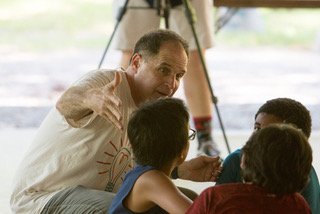David is the Founder and Director of the Teaching Empathy Institute, which provides a holistic approach to quality education that takes into account the social, emotional, and leadership skills for student success in the 21st century. He is an educator, writer, musician, and a nonprofit leader with more than 30 years of experience working in a multitude of educational settings, as a teacher, facilitator and systems change specialist.
Between 2014 and 2016, he worked for Turnaround for Children in New York City, as a designer and coach. Turnaround works with high-poverty schools in NYC, Newark, NJ, and Washington, DC, facilitating learning environments that meet the physical and emotional needs of all students.
Rufina: What does empathy mean to you?
David: People always say that empathy is walking a mile in someone else’s shoes. But to me, it’s a layered process and starts with an intention of caring. I define empathy as being able to imagine what someone else is feeling without judgment. It’s important to remember that each person has a unique life story. We don’t know what chapters have come before, we can only imagine as a pathway to understanding what they are feeling and what they are needing from us. .
Why does empathy matter for schools today?
Whether it’s in school, the home or in the community, children today have a higher level of anxiety and it plays out in their behaviors. Often these children lack pro-social skills to assist them when under social stress, and often they express their emotional needs through anti-social behaviors. Many well-intentioned Teachers who are ill-equipped to understand this can, who lack empathy, often unintentionally escalate these behaviors–such as bullying or other low-level forms of aggression.
When did empathy become a focal point of your career?
One day, I heard a song which told true story of a boy, Howard Gray. Howard was bullied and victimized by others because he was different. In the song, one of his classmates, who wanted to help him, chose to remain silent, for fear of being rejected himself. I learned the song and started singing it for students, parents, and educators.
The song was a powerful entry into real-life dialogue about the challenges involved in social-decision making and the learning sessions associated with Howard’s story, whether with children or adults, became the most profound of my teaching career. Over time, I came to call these sessions using music as music/dialogue. Dialogue in and of itself, represents the practice of empathy. It involves asking open-ended questions without judgement, summarizing back what you heard, and reflecting the feelings of others within the group or class.
In the course of these “Howard Gray music dialogue? Sessions, I I would ask the students, “Has this happened at your school? What are the reasons people are treated this way?” this would lead to a brainstorm of ideas as to why people were rejected. Inevitably, one of the answers as to why people were rejected and/or alienated was that they were different.
Others included: -the country they are from, their skin color, the food they eat, or they are not a good athlete, just to name a few. Their answers were authentic and heart-felt and the combination of the song, their answers and the follow-up discussions created the recipe for meaningful and life changing social reflections.
How do you work with schools?
Meeting the needs of the community is the top priority. I present a process, not a templatized program, but one that is needs-oriented aimed to fit the unique school and community with which I’m working. I seek to understand the needs of the children, the staff, the schools, and school districts by talking to community members to see if I can help them create emotionally safe schools. Sometimes I look at the school’s data like statistics of suspension rates and disciplinary referrals, but I focus more on learning through dialogue with leadership, teachers, support staff and students. . I host appreciative inquiry sessions in which we focus on what people appreciate about their school community. Through these inquiry sessions, I extract central themes that often touch on issues of diversity, community-building, appreciation for those who are different, and , understanding and valuing the life stories of others.
With this knowledge, I present to the school leadership a plan of action for building an empathic learning community in which all people are accepted. Where all people belong. My work is often delivered as a parallel learning experiences meaning, I I work directly with students, teachers, para-professionals, leadership and para-professionals. My work is grounded in research on resilience, emotional safety, systems change, and the connection between music, neuro-science and self-discovery.
What are some ways empathy can be taught alongside other subjects?
- – There are numerous ways that educators can infuse empathy into their teaching and classroom culture. Here are some examples:
- – Literature: Examine the various perspectives of the main characters in any story your class is studying.
- – Social studies: Infuse the concept of empathic decision-making when it comes to examining how different groups of people are affected by governmental policy decisions.
- – History: Highlight successful diplomatic efforts throughout world history that were enhanced by the empathic practices of listening non-judgmentally with understanding and compassion.
- – Resolving and mediating conflicts: Apply conflict resolution to the daily relationships that exist between your students and teachers within the school community. Use empathic practices when intervening or mediating between two or more students who are in conflict or disagreement.
- –
Do you have any last words for Ottiya educators and parents all over the world reading the Empathy Issue?
Remember that children are the sacred beings in our communities and our role, whether as a parent, teacher or other significant adult, is a noble gift for the future of the world.
Recommend0 recommendationsPublished in Social-Emotional Learning, Teens
